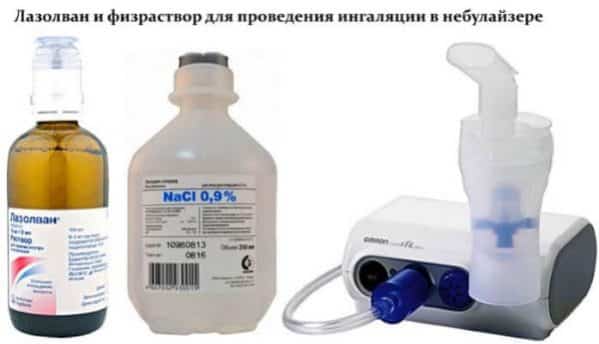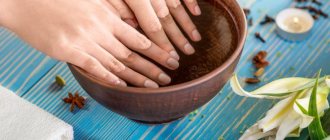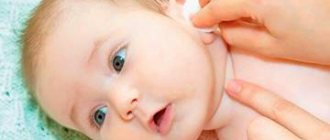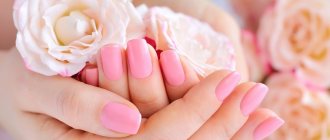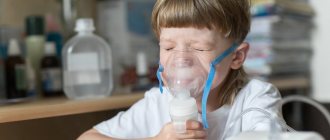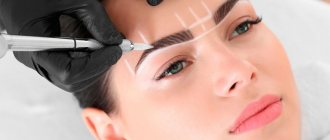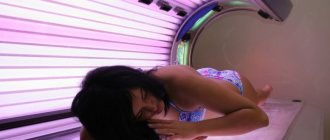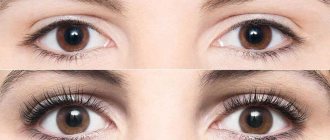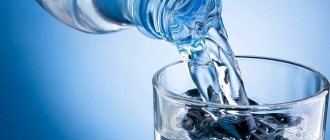There are legends about the healing properties of Borjomi water. This is a real healing liquid that is used for various diseases, ranging from diabetes to cancer. But it is worth mentioning that in large quantities mineral water becomes dangerous because it can cause ulcers, which is due to the alkaline nature of the drink. Inhalations with Borjomi in a nebulizer help get rid of dry cough and help soften sputum.
Recipes for adults
To alleviate the condition, inhalations with saline and sea water can be performed repeatedly throughout the day.
Procedures using alkaline mineral waters of Borjomi or Esentuki have no contraindications and help soften mucus in the nose and moisturize the mucous membrane. There are folk recipes for solutions that are quite effective at home:
- dissolve 1 teaspoon of salt in 1 glass of boiled water and add 20 drops of sea buckthorn oil, heat the mixture and pour into the nebulizer compartment;
- A solution with Kalanchoe juice is prepared in the same way.
These mixtures are intended for single use and are discarded after each procedure. Solutions containing medications prescribed by doctors are more effective. The dosage is also indicated on the prescription sheet.
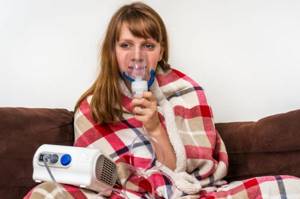
Dosage and method of administration
Adults are recommended to use the following inhalation recipes for a runny nose using a nebulizer:
- dilute an interferon ampoule (“Laferobion 500”) with 2 ml of sterile liquid;
- for a disease caused by staphylococcus, chlorophyllipt is diluted 1:10;
- the homeopathic drug Tonsilgon can be prescribed to both children and adults, but in different dosages: for children 1:3, and for adults 1:1;
- vasoconstrictor drugs (Xylometazoline) in the amount of 2 drops are diluted in 3 ml of saline and used for chronic nasal congestion and difficulty breathing;
- for prolonged rhinitis, a local antibiotic Bioparox or Isofra is injected once into 3 ml of saline;
- Rinofluimucin is a drug based on two antibiotics, used for viscous mucous discharge. The dosage is determined by the therapist.
Pregnant women should use any medications for inhalation with caution, and folk recipes should be approached wisely. Such a popular method as steaming potatoes can cause burns to the mucous membrane and cause problems with pregnancy.
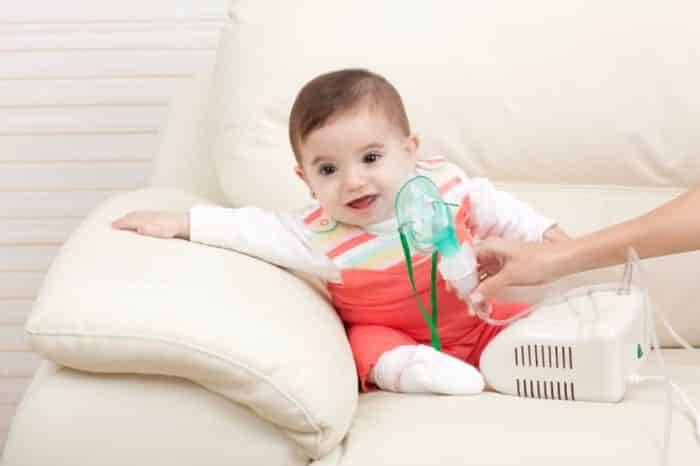
How to breathe through your nose with a nebulizer
Before starting inhalation, you need to prepare the nebulizer: assemble it, rinse the medicine container, and connect it to the power supply.
Then you need to prepare a medicinal solution, observing the proportions. If the medicine is stored in the refrigerator, be sure to warm it to room temperature before use.
Patient preparation rules:
- measure body temperature;
- do not eat food 1.5 hours before inhalation;
- do not leave the house for about an hour after the procedure and limit conversations;
- rinse your mouth with clean water after inhalation;
- Do not add oils to medicinal solutions.
Inhalations should be carried out in a sitting position, the mask should cover the nose and mouth without causing discomfort. You need to calmly and slowly inhale the vapor through your nose and exhale through your mouth so that the drug is evenly distributed in the nasopharynx. To treat a cold, 5-7 sessions are usually enough.

Cold medicine for nebulizer
Inhalations using a nebulizer are part of the complex treatment of diseases of the respiratory tract and ENT organs. As a medicine, you can buy solutions or special nebulas. There are several medications that can be used in a nebulizer, but they must be diluted with 9% sodium chloride . For a runny nose, the following medications are most often used:
Dekasan . A drug with a pronounced antiseptic, antimicrobial, bactericidal effect. The basis of the medicine is decamethoxin , the use of which can reduce swelling of the mucous membrane and suppress the aggressiveness of pathogenic microorganisms. If you have a runny nose, inhalations with Decasan should be done at the first signs of illness.
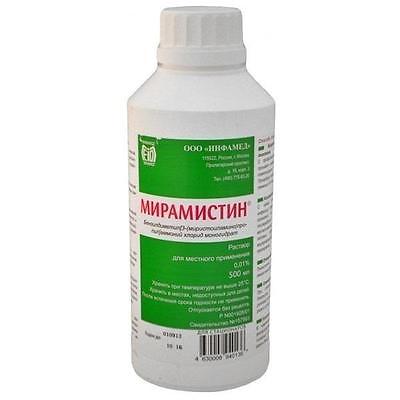
Benefits of the inhaler
Ultrasonic vibration is applied to the solution, turning it into steam. The advantage of this approach is the smallest droplet size of 2-3 microns, which helps the inhaled drug reach small bronchi. Another advantage is quiet operation. The disadvantage of ultrasonic nebulizers is the inability to use certain medications.
They are noisy, but their advantage is versatility. Any medicine can be used.
The compressor creates a strong air flow, entering the spray bowl it comes into contact with the medicine and an aerosol with parameters up to 5 microns is formed. This size is optimal for getting the medicine into the lungs.
Essential oils
Baking soda. A 2% soda solution is used to create a healing environment in the respiratory tract. Pathogenic bacteria cannot survive when the pH level increases from acidic to alkaline. Inhalation of soda makes the removal of mucus and pus from the nose almost twice as effective.
A solution of table salt in a concentration of 1%-2% does not irritate the mucous membrane, but rather softens and cleanses the nasal cavity from mucus formations.
Bronchodilators
Berodual is a fast-acting drug, effective for up to 6 hours after use. Widely used to combat bronchospasm.
Berotec (fenoterol) is an inhaled bronchodilator that relaxes the smooth muscles of the bronchi and relieves bronchospasm. It is used in 2 ml of 0.1% solution 3-4 times daily. Berotec has a rapid bronchodilator effect.
Salbutamol is a drug of synthetic origin, has a bronchodilator effect, eliminates spasm during breathing and suppresses bronchial reactivity, increases the effective capacity of the lungs. Salbutamol for inhalation is available in aluminum cylinders with a dispenser. The product is sprayed when you press the dispenser, 0.1 mg as 1 dose in the form of tiny particles.
Mucolytics
Acetylcysteine - 20% solution is used for inhalation, 2-4 ml 3-4 times a day.
Mucomist - for inhalation it is necessary to dissolve 0.2 g of the active substance in ampoules in 1 ml.
Pulmicort - use a suspension of 0.25 mg twice a day.
Furacilin is used for acute diseases of the upper respiratory tract. Inhalations of 2-5 ml are carried out 2 times daily (1:5000).
Malavit is used as an antiseptic and antibacterial agent with antiviral and antifungal properties. One of the features is that it has an analgesic effect.
Streptomycin is used only as a freshly prepared solution of 0.2 - 0.25 grams of streptomycin in 3-5 ml in sodium chloride solution daily.
Tubazid is used in a 6% solution of the drug, 21 ml 2 times a day.
Benefits of using an inhaler:
- moisturizes the nasopharyngeal mucosa and softens dried mucus;
- does not cause allergic reactions;
- facilitates breathing, promotes mucus removal;
- evenly distributes the active ingredient of the drug to all areas of the mucous membrane;
- The device is easy to use and allows you to strictly follow the dosage of the medication.
Contraindications
Before starting therapy, it is advisable to consult a doctor and establish an accurate diagnosis. A healthcare professional can tell you which drugs or herbs are most effective for inhalation therapy.
Procedures cannot be performed if:
- elevated body temperature (you can breathe cold steam from a nebulizer up to 37.7 °C, for thermal procedures the limit is 37.1 °C);
- the appearance of purulent discharge;
- heart failure;
- vomiting;
- nosebleeds.
People prone to allergies need to be careful when choosing medications for treatment or using folk remedies for the common cold. The list of contraindications for steam procedures also includes pregnancy and age under two years.
Older children are advised to make them using a teapot. The healing liquid is poured into a container, a watering can or a cone made of thick paper is inserted into the spout, through which the child should inhale the healing vapors
The list of contraindications for steam procedures also includes pregnancy and age under two years. Older children are advised to make them using a teapot. The healing liquid is poured into a container, a watering can or a cone made of thick paper is inserted into the spout, through which the child must inhale the healing vapors.
Inhalation methods of treatment for rhinitis can quickly relieve congestion, facilitate the passage of mucus and improve well-being. When performing them, you can refuse to use nasal drops and sprays. You need to breathe herbs, oils or medicinal substances 2-4 times a day.
With the onset of cold season, the question of how to deal with the manifestations of the disease arises. Cough and runny nose come first. Symptoms can be eliminated with the help of medications, but you can try other methods and purchase an inhaler for cough and runny nose. Breathing over steam was popular and had a good therapeutic effect even with our grandmothers, and now you can purchase modern devices for carrying out the procedure instead of saucepans and basins.
What is a nebulizer, and what types are there?
A nebulizer is a device that turns various substances into an aerosol. This inhaler can be used with a wide variety of medications. In addition, the device is very convenient to use; it can be used both in the hospital and independently at home. There are also portable nebulizers; you can easily take them with you on vacation, on business trips, and, in general, on any trip.
An alternative to a nebulizer is regular steam inhalation. They are usually carried out at home by dissolving a cold medicine in water, and then heating the water to boiling point. When the steam begins to rise, the patient inhales it and inhales the vapor of the medicine along with it. However, it is worth noting that this method is not suitable for everyone. For example, steam inhalations should not be used on infants. In addition, steam inhalation can cause burns to the internal respiratory tract. Inhalation with a nebulizer for a runny nose is a more effective and safe remedy.
All models of nebulizers can be divided into three main types:
- Ultrasonic nebulizer - this device operates thanks to a built-in special plate that vibrates. The main advantage of this option is noiselessness and low weight. It is very convenient to use this nebulizer with a small child, as it will not scare him.
- Compressor nebulizer - a compressor operates inside this device, which actually turns the medicinal substance into an aerosol. Such a device is inexpensive and is capable of spraying a wide range of different medications. However, there is one drawback - noise during operation. Using an inhaler is difficult for people with small children. As a rule, this has to be done during the absence of children.
- Mesh nebulizer is a more modern inhaler for the common cold, it includes the properties of the two previous ones. The inhaler works with most medications for the common cold. The device is almost silent and easy to use, however, it is quite expensive for such inhalers.
Nebulizers can also differ in appearance and built-in functions. For example, there are inhalers in the form of children's toys. Using a device like this to give a nebulizer inhalation to a child with a runny nose is very simple, since the child is distracted by the toy, and the treatment process itself takes place in a playful way.
Adults can choose an inhaler depending on its functions. For example, some nebulizers have several operating modes. Each mode sprays particles of a substance of different sizes. This allows you to choose the optimal inhalation option for yourself.
https://youtube.com/watch?v=3612MLaIdvE
What medications are used for the nebulizer?
Various medications are used for nebulizer therapy. Depending on the complexity of the disease and its form. Only a medical professional can correctly determine the form of the disease and determine what medications are needed for treatment. The group of solutions used for inhalation therapy includes: antibiotics, bronchodilators, antiseptics, mucolytics, alkaline.
The following nebulizer medications are used for a runny nose:
- Interferon - used for the treatment of viral infections and for prevention purposes;
- Fluimucil - antibiotic, treatment of bacterial infections;
- Furacilin - therapy for ARVI;
- Chlorophyllipt - staphylococcal infections of the nasopharynx;
- Tonsilong - prolonged diseases of the nasopharynx;
- Alcohol infusion - critical inflammatory processes in the nose;
- Calendula tincture - aggravated inflammation in the nasopharynx.
If you know how to use medical substances in the inhalation unit for rhinitis or runny nose, you can get rid of the disease in a few days. Moreover, in the absence of special medications, it is known that inhalation can be carried out with simple medications that are available at home for instillation in the nasal cavity.
Naphthyzin can be such a medicine. It is mixed with saline and inhaled twice a day.
For acute purulent rhinitis, if a dense yellowish or greenish secretion is released from the nose, you can use the bactericidal preparations Polydex or Bioparox. If rhinitis is chronic, then inhalations with immunomodulating agents are prescribed.
Some substances are not suitable for use in the device. For this reason, it is necessary to study the instructions before using this device. Instructions for using a nebulizer for a runny nose may contain a list of medications prohibited for use. As a rule, these are preparations that have oils in their structure. Oils clog the channels of the device and disable it. In addition, canals and herbal infusions clog, as they contain large particles that are difficult for the device to filter.
It is extremely important to adhere to the dosage of solutions and use saline solution in the nebulizer, and not plain water.
Interesting! Instead of saline solution, it is appropriate to use mineral water.
Types of drugs for inhalation: classification
In order for the medications prescribed by the doctor to have the maximum effect, you need to know what to pour into the nebulizer first, second, etc.
It is necessary to administer medications in the following sequence, and a break of at least 15 minutes must be maintained between procedures.
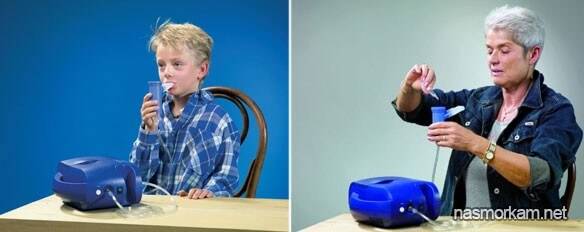
Bronchodilators Medicines in this group are used to dilate the bronchi when they are obstructed (narrowed), which is typical for bronchial asthma, obstructive bronchitis, laryngitis, etc. They are taken only as prescribed by a doctor, strictly observing the accuracy of dosing. These include:
- Atrovent
- Salgim
- Berodual
- Ventolin
- Salbutamol
- Berotek
Mucolytics They help thin mucus and facilitate its passage. These are drugs such as:
- Ambroxol,
- Flavamed,
- ACC,
- Fluimucil,
- Bronchipret,
- Ambrobene,
- Lazolvan,
- Ambrohexal
Anti-inflammatory and hormonal agents, antibiotics and antiseptics
- Pulmicort
- Nasonex
- Dekasan
- Miramistin
- Rotokan
- Eucalyptus tincture
- Fluimucil-antibiotic IT
- Chlorhexidine
- Furacilin
- Tonsilgon N
Corticosteroids have pronounced properties that quickly stop all manifestations of the inflammatory process.
Therefore, they are often prescribed for adenoids, sinusitis and some other ailments.
Antiseptics and antibiotics that directly affect pathogenic microflora are among the last to be introduced, when all obstacles to their penetration to their destination have been eliminated.
Antihistamines (Cromohexal, etc.). They block the binding of histamine (the main mediator of allergies) to the corresponding receptors. Thanks to them, a runny nose, nasal congestion, sneezing and other signs of an allergic reaction are eliminated. But they are rarely prescribed for coughs (the indication for this is bronchial asthma of allergic origin). Immunomodulators (Derinat, Interferon). These drugs are also called antiviral drugs. They increase the body's resistance, so they are advised to be taken from the first days of the development of ARVI. Each drug has its own characteristics in how to prepare a solution for inhalation, which determines its dosage. But almost all of them are taken three times a day, taking 3-4 ml of the product diluted with saline solution per procedure. But before using any of them, you should consult a doctor.
The best compressor nebulizers
Modern compressor inhalers received quite high ratings in customer reviews. They are easy to use and maintain, have a low price, and therefore are in demand and popular.
MicriLife NEB 100 B
A high-quality and powerful device from a Swedish company that runs on a durable and reliable piston compressor. The kit includes nozzles for nasal and oral inhalations, masks for adults and children.
can work . During the procedure, it converts the medicine into tiny particles, which helps cover a large area that is needed for irrigation. The device operates quietly and turns off automatically.
Omron CompAir NE-C28
An excellent modern compressor device, the internal compressor of which can operate for an unlimited amount of time , and special valves significantly save medicine. The kit includes a portable bag, attachments for children and adults, and filters for various medications.
B.WELL WN-115K
One of the best compressor nebulizers for children. The device is made in the form of a train with funny stickers and flickering lights. In their reviews, many parents praise this particular model. Adults can also use it.
The inhaler atomizes the medicine to the smallest particles, delivering the medicine to the upper and lower respiratory tract. It is easy to use and maintain, but can work continuously for only twenty minutes. The device is quite noisy, but high quality and inexpensive.
Essential oils for inhalation for runny nose and colds
As we know, medicinal herbs contain healing essential oils, which are actively used in cosmetology and alternative medicine. You can purchase oils at most pharmacies and beauty salons. If you don’t have a suitable herb in your home medicine cabinet, you can use essential oils, which are added dropwise to the inhalation solution (usually from 2 to 10 drops).
Inhalation with essential oils for a runny nose is not only a pleasant, but also a very useful procedure, because esters are volatile substances that easily penetrate the nasal passages and envelop the nasal mucosa, creating an invisible film on it. Depending on the properties of the plant whose essential oil is used in inhalation, we obtain anti-inflammatory, soothing, antimicrobial and antiviral effects.
Most often, for colds and runny nose, people turn to eucalyptus ether. And this is not surprising, because this plant is considered the strongest protector against colds. It is not without reason that in those places where eucalyptus trees grow in large numbers and the air is saturated with healing ether, people practically do not know what respiratory infections are.
The next most effective is coniferous tree oil. The situation with coniferous forests is identical to eucalyptus forests. People living near them rarely get colds. This speaks in favor of using essential oils of pine, juniper, and fir for runny noses and colds.
Very popular for colds and coughs are inhalations with fir oil, which has a disinfectant, anti-inflammatory and antimicrobial effect, facilitating the removal of mucus from the nasal passages and increasing local immunity. In this case, you will need to take only 2-3 drops of ether per liter of warm water.
If there is no essential oil of eucalyptus and coniferous trees in the house, this is not a reason for despair. There are many other oils that have a healing effect for a runny nose: oil of lemon, orange, mint, cypress, lavender, chamomile, tea tree, etc. Oils can be taken individually or in a mixture.
For example, adult patients can undergo steam inhalations with bitter orange and rosewood oils (2 drops per liter of hot water) with the addition of 1 drop of black pepper oil. Or take a mixture of these oils:
- cinnamon and lemon (3 drops each)
- lavender, pine and thyme (1 drop each) plus 3 drops eucalyptus oil
- eucalyptus, pine and lemon (or orange) 3 drops each
- juniper (3 drops) – a particularly effective remedy at the very beginning of the disease
- mint (3 drops), fir (2 drops), eucalyptus (1 drop)
- tea tree, eucalyptus and mint (2 drops each) - a good option for nasal congestion
- lavender, eucalyptus and rosemary (2 drops each) – suitable for both prevention and combating the first signs of a cold.
Inhalation steam procedures with essential oils should be carried out without covering your head with a towel, especially if more than drops of oil are added to the water. The duration of such procedures usually does not exceed 10 minutes (5 minutes is enough for children). The frequency of procedures is usually 1-2 times a day.
In addition to steam procedures, you can perform air inhalations, which are more suitable for young children. Water, in which a few drops of oil are dissolved, is sprayed with a spray bottle into the room where the child is, and he breathes healing vapors without interrupting his games or while sleeping. You can use an aroma lamp with appropriate essential oils.
Another inhalation option that does not require a child or adult to sit over a saucepan for ten minutes is baths with essential oils. A few drops of oil added to the bathing water will make the procedure not only pleasant, but also useful (warm water promotes the evaporation of the ether, and it will enter the nasal passages during breathing). The same oils can be used as for steam inhalation.
You need to select aromatic oils according to the same principle as herbs. The ether must have the properties necessary for a runny nose and not cause allergic reactions.
[]
The use of inhalations with saline solution for a runny nose
Inhalation of saline solution for a runny nose has long been prescribed by many doctors for both children and adult patients. They help to quickly restore the normal state of the nasal mucous membranes, remove excrement, facilitate nasal breathing and speed up recovery.
How effective is saline solution for a runny nose?
There is no better way to moisturize your nose than inhaling with a saline solution. Salty drops cannot completely treat all nasal passages, and sprays are contraindicated when the child is sick. In this case, rhinitis should be treated only on the advice of a pediatrician.
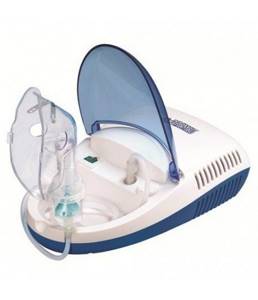
Use a nebulizer for cold
After inhalation, no immediate effect is observed. Saline solution for a runny nose does not immediately relieve swelling after the first session and does not quickly clear the nose. Only after several days of daily use of the treatment solution will you notice a decrease in swelling and a decrease in the number of nozzles. Saline solution for a runny nose helps:
- to maintain the healthy state of the mucous membranes during prolonged runny nose, when the immune system itself is busy fighting the disease;
- quickly remove pathological viruses, fungi, allergens or bacteria from the nasopharynx, which interfere with local protection and release toxins;
- prevent cracks and dried crusts in the nose;
- shorten the duration of the disease and reduce symptoms.
What is prohibited from using a nebulizer
Treatment of rhinitis involves the use of the correct solutions. The following cannot be used as inhalation medications:
- Vasoconstrictors, which, if they enter the bronchi, can cause respiratory problems.
- Herbal decoctions and infusions can cause damage to the device when their particles get into different parts of the device. And also steam from plants, entering the bronchi, can lead to an allergic reaction.
- Oils are not used for inhalation using a nebulizer, as this risks damaging the device. They also cannot be used to treat diseases of the nasal cavity, as they can cause the development of pneumonia.
Inhalation for a runny nose is carried out with a medicine that was selected by the attending physician together with the patient. It is possible that at a certain stage of the disease the patient will be prescribed an antibiotic or other potent drug.
The doctor will advise you on solutions: which ones are suitable for certain symptoms, and will give you recipes with ingredients and proportions.
Pharmaceutical solutions or infusions that can be poured into an inhaler will help get rid of a runny nose. They reach the counter after careful filtration, so they have a high degree of purification. There are also ready-made fees without the need to comply with proportions. Before using them, you just need to read the instructions and study the composition with the components.
Drugs approved for use in a nebulizer for the treatment of rhinitis
Inhalation for a runny nose is done using the following solutions used in a nebulizer:
- Immunostimulating drugs. These are Interferon and Derinat.
- Solutions of alkali and salt. They are prepared from mineral water, sodium chloride or its bicarbonate.
- The procedure is carried out with drugs that have antibacterial or antiseptic effects. This group is headed by “Dioxidin”, “Streptomycin”, “Furacilin”, “Fluimucil”, “Ceftriaxone”.
- The approved anti-inflammatory medications include the best ones, which show good results in the treatment of the common cold: Cromohexal, Pulmicort, Dexamethasone.
Pregnant women should use inhalations very carefully. You should carefully study the composition of each drug and only then make your final choice.
If the inhaler product has a strong odor, it is better not to use it so as not to provoke toxicosis.
The best recipes for use in an inhaler during pregnancy are the following:
- Mineral water with a slightly alkaline reaction helps to cope with both rhinitis and cough.
- Saline solution or physiological composition is used for identical manifestations.
- Potato inhalation is an excellent old-fashioned method that allows you to treat runny nose and cough in pregnant women. For the procedure, you need to stock up on three medium-sized potatoes. They are cooked until tender, after which the boiling water is drained and the vegetables are mashed. Covered with a blanket, the woman in position inhales the fumes of potatoes, bending her head over the pan.
Do inhalations with saline help with a runny nose?
In the past, it was believed that vasoconstrictor drops were a panacea for the common cold. These products quickly relieve swelling of the mucous membranes and restore normal breathing. However, recent research increasingly points to the unsafe use of such products, especially among children.
Moreover, there are so many other ways to cure rhinitis without consequences. And one of them is inhalation.
How to properly inhale a saline solution for a runny nose and are there any contraindications to this procedure? Let's consider the main nuances.
Basic properties
Sodium chloride is an isotonic salt solution with a concentration of 0.9%. This concentration of sodium chloride is contained in the blood plasma, which makes its use for the prevention and treatment of the common cold absolutely safe, regardless of the patient’s age.
https://www.youtube.com/watch? v=VgJaRr_7A9E
Therapeutic effect by inhalation:
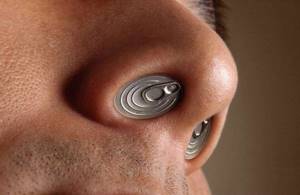
Elimination of inflammation and swelling of the mucous membrane without affecting blood vessels;- Relieving nasal congestion;
- Moisturizing the mucous membranes to restore their protective functions;
- Preventing dry mucous membranes, cracking and crusting in the nasal cavity;
- Cleansing the nasal passages from accumulated mucus and, as a result, from pathogenic microflora that provokes the development of the inflammatory process;
- Strengthening local immunity;
- Decreased mucus secretion;
- Preparing the nasal cavity for injection of other medications and enhancing their therapeutic effect.
Recipes for inhalation with a runny nose using a nebulizer
Inhalations for adults are carried out using the following recipes.
Oil for inhalation.
Essential oils are very effective in treating a runny nose through inhalation. They contain useful substances and vitamins that make the healing process faster.
The oils do not cause allergic reactions, but some patients need to be careful with them, particularly those who suffer from hypertension, heart failure or pulmonary failure. They use not only one oil, but also mixtures of them. The most commonly used oils are eucalyptus, lavender, pine, fir, juniper, as well as tea tree and thyme oils.
Inhalations with soda.
Soda used for inhalation is very beneficial for mucous membranes, relieves inflammation, fights germs and viruses. Soda is widely used to treat not only a runny nose, but also various types of cough.
Water for inhalation with soda should not be hot, as it loses its beneficial properties, and, in addition, you can burn your respiratory tract. The duration of this procedure is no more than 10 minutes.
Inhalations with chamomile.
Chamomile contains many essential oils that have antispasmodic, anti-inflammatory and diaphoretic effects, which are very effective for colds.
Preparation: grind chamomile, pour a glass of boiling water over it and let it brew for 30 minutes. Then add water to make 1 liter of solution.
Chamomile is widely used to treat runny nose in children, as it does not cause allergic reactions. The main condition is that the steam from the medicinal solution should not be too hot.
Inhalations with Miramistin.
Miramistin is suitable for both adults and small children (including infants), and even for pregnant and lactating women. However, dosages for children and adults are different. The inhalation time is 10-15 minutes, the procedure is carried out 3 times a day. Before inhalation with miramistin, you should definitely consult your doctor.
Inhalations with Interferon.
Heat the saline solution to a temperature of 37 degrees, add 3 ampoules of Interferon to it. Pour 4-5 ml of solution into the nebulizer reservoir.
Inhalations with Tonsilgon.
The medicine has anti-inflammatory and antimicrobial effects. To prepare the product, you need to mix Tonsilgon with figra solution in a 1:1 ratio.
Inhalations with medicinal herbs.
The following infusions are used for the procedures: St. John's wort, oregano, coltsfoot, pine buds, pine and spruce needles, raspberry leaves, blackberry leaves, black currant leaves, chamomile flowers, calendula, linden, lavender and sage. The decoction is prepared as follows: add 1 tablespoon of the selected medicinal herb to 200 ml of water and bring to a boil. The solution is infused for 1-2 hours. The finished infusion is added to water for inhalation.
Various mixtures of herbs can be used. For example, this: mix linden flowers and leaves, chamomile, mint, oregano in equal proportions. Pour 6 tablespoons of the mixture into 1 liter of boiling water. The solution must be infused for 20 minutes, after which 4 drops of eucalyptus essential oil are added to it.
Inhalation with pine buds (3 tablespoons of buds are boiled for 15 minutes in 1 liter of water) and crushed eucalyptus leaves (2 tablespoons of raw materials per 1 liter of water) has been widely used.
Inhalations through a nebulizer - recipes
In order to cure a runny nose in a child or adult, you can use some solutions, mineral waters, and decoctions of medicinal herbs. Good results can be obtained from the following products, which are completely safe for inhalation:
We recommend reading - Recipes for inhalations for a runny nose.
Sodium chloride (saline solution) . In nebulizer therapy it is used as a solvent for various medicinal solutions, but inhalations can be done with 9% sodium chloride itself. Such inhalations with saline will help cleanse the nasal mucosa of accumulated mucus and reduce swelling.
You might be interested in: Ambrobene with saline solution for inhalation for children.
Borjomi . Mineral therapeutic and prophylactic water with a pronounced mucolytic effect. Inhalations with Borjomi will help speed up the removal of mucus, reduce swelling, and improve nasal breathing. Procedures can be performed up to 4 times a day.
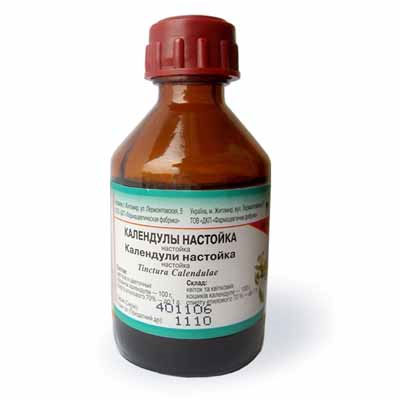
Tincture of calendula. For inhalation, you can use an alcohol tincture, which must be diluted 1:40. Inhalation can only be performed by adults. You can replace calendula with alcohol tincture of propolis.
Propolis tincture for children with a runny nose - we recommend reading.
Inhalations through a nebulizer can be used at any stage of rhinitis, but a particularly good result can be obtained in the first days of the disease, when a viral or bacterial infection has not had time to penetrate the deep tissues of the nasal mucosa and respiratory system.
Recommended reading: Nebulizer solutions.
Procedures for a child
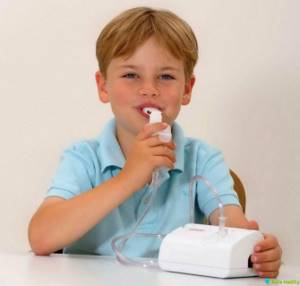
Pediatricians recommend inhalation for a runny nose with a nebulizer for children. This method of treatment is safe for the child’s body, since the possibility of overdose is eliminated. The choice of medication for the procedures is made by the attending physician.
Inhalations in childhood are carried out using the following means:
- mineral water;
- Interferon;
- Miramistin;
- saline;
- Furacilin solution.
Such products are completely safe for children. The action is aimed at moisturizing the mucous membrane and reducing the activity of pathogenic microorganisms. The use of antiseptic solutions helps remove mucus, making snot go away much faster.
In childhood, infectious diseases usually occur without complications. However, with reduced immunity, the presence of chronic pathologies or congenital disorders, treatment with a nebulizer may be less effective.
It is recommended to carry out steam inhalations for children with a runny nose using Chlorophyllipt, eucalyptus or peppermint oil.
A number of conditions must be met:
- It is forbidden to carry out inhalation on an empty stomach;
- The patient's body temperature should not be higher than 37.5 degrees;
- after completion of the procedure, it is forbidden to eat for 40 minutes;
- after completion, the child should not talk for at least 30 minutes;
- at the age of 2 to 5 years, the duration of the procedure is no longer than 3 minutes;
- children from 5 to 12 years old are allowed to breathe steam for 5 minutes;
- the inhalation solution is prepared immediately before administration.
When using a nebulizer, you should follow the recommendations described in the instructions for the device. After each procedure, you need to thoroughly rinse the container for the medicinal solution, as well as the tube and breathing mask.
Rules for the procedure
Let's figure out how to give children inhalations with a Borjomi nebulizer. You must adhere to the following rules:
- The first step is preparing mineral water. It should be left overnight with the lid open so that the gases evaporate a little, but important substances remain.
- It is not recommended to inhale with a nebulizer after meals or physical activity. The interval should be 40-60 minutes.
- According to the instructions for the device, you need to pour liquid into the reservoir. The volume of mineral water should not exceed 5 ml.
- When coughing, inhalations with Borjomi using a nebulizer are done through a mask. For a runny nose - through a nasal cannula.
- Under no circumstances should you add various oils or aromatic herbs. The device is not intended for such mixtures.
- The procedure should take place in a relaxed state. You need to make sure that the child inhales the vapor deeply and does not get distracted.
- The duration of the procedure is 5-7 minutes.
- After the session, it is not recommended to drink, eat, or engage in active sports immediately.
- Finally, you need to wash the parts of the device so that it is ready for the next procedure. This is a very important final stage, since an acute cough attack can appear at any minute and the nebulizer needs to be clean and neatly folded.
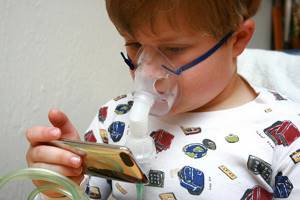
Inhalations for a runny nose in children
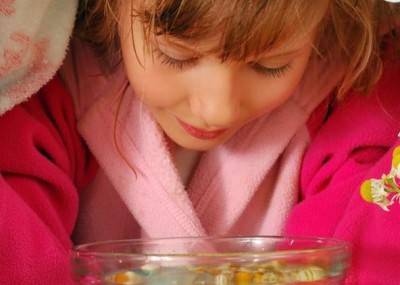
Inhalation is the inhalation of medications for therapeutic purposes. Such procedures have been known for a very long time. And modern doctors, at the first signs of a runny nose in children, recommend inhalation. In addition, inhalations are done for tonsillitis, pharyngitis, bronchitis and pneumonia. Attacks of bronchial asthma are also well relieved by inhalation.
How to inhale when you have a runny nose?
For inhalation to have an effect, it must be done correctly. This procedure can be done one hour before a meal or an hour and a half after a meal. If a child’s body temperature is above 37.5°C, inhalations cannot be performed. It is not recommended to go outside for three hours after inhalation.
To avoid burns, never force your child to breathe in very hot steam. The optimal temperature for inhalation is up to 40°C. Explain to a 3-4 year old child that when they have a runny nose, they need to inhale and exhale the medicinal aerosol only through the nose.
What inhalations should be done for a runny nose? The easiest way is to use a proven method: do steam inhalation with essential oil. Such inhalations can be performed on children over 3 years of age. The use of essential oils is prohibited if the child is allergic to them or has bronchial asthma. Most often, oils of eucalyptus, fir, pine, a mixture of lemon and cinnamon, lavender, pine, thyme and others are used for a runny nose. Place a few drops of oil into a kettle or pan of hot water, cover yourself with a towel with your child and breathe in the pleasant healing steam, which will help cure a runny nose.
A more modern way of giving a child inhalations for a runny nose is to use a nebulizer. This is an ultrasonic or compressor inhaler that sprays small particles of medicinal solutions. And these tiny droplets penetrate deep into the bronchi, which enhances the effectiveness of the procedure. If you set the nebulizer to spray medications with larger particles, they will settle in the nasal passages and help treat a runny nose in a child. For very young children there are special inhalers with a mask. Such nebulizers are used for inhalation in both sitting and lying positions. The procedure is carried out for approximately 10 minutes.
Using a nebulizer, you can moisten the child’s nasopharyngeal mucosa with saline solution, which is especially important in rooms with excessively dry air.
Herbs for inhalation for a runny nose
Using a nebulizer, you can make inhalations for a child with a runny nose using the following recipes:
1. Inhalations with medicinal infusions. Infusions can be made according to the following recipes:
- pine buds - 3 tbsp. spoons;
- eucalyptus leaves - 2 tbsp. spoons;
- collection of calendula flowers, eucalyptus leaves, St. John's wort herb in equal quantities (about 4 tablespoons in total);
- collection of chamomile flowers and eucalyptus leaves in equal quantities (about 4 tablespoons).
Pour the indicated amount of herbs into 1-2 liters of boiling water, keep on medium heat for 5-10 minutes, and then leave for half an hour. Before the procedure, the infusion is heated and poured into a nebulizer. This infusion can be used within two to three days if stored in the refrigerator.
2. Inhalations with Kalanchoe juice. This plant helps fight viruses and has an anti-inflammatory effect. For
3. For inhalation for a runny nose, you can use the pharmaceutical drug “Rokotan” - this is an extract of yarrow, chamomile and calendula. In half a liter of water you need to dilute 2 tbsp. spoons of this product, pour the prepared solution into a nebulizer and breathe in the aerosol.
4. Inhalations with an alkaline Borjomi solution help to thin the mucus in the child’s nose and facilitate its better removal.
The use of inhalations to treat a runny nose helps your child heal faster and more effectively.
WomanAdvice.ru>
which inhalers are better reviews
site about respiratory diseases and related things We got sick again. This time, the pediatrician, among other things, advised the use of inhalations using, for example, a nebulizer. For a long time I couldn’t figure out which one to take (there are so many of them now), which one would be useful, help with various diseases, suit the whole family and will last a long time... I re-read a whole bunch of articles and only this one turned out to be truly useful!!! This is not advertising - this is a hard-fought search for the necessary information. I’m sharing...
How to choose the best inhaler (nebulizer) to treat a child?
In modern medicine, one of the most common and effective methods of treating respiratory diseases is the use of the inhalation method of administering drugs.
This method of treating respiratory diseases has clear advantages over others, because it allows you to immediately deliver the drug in the minimum effective dosage to the tracheobronchial tree. At the same time, the absorption of the drug is so high that the effect occurs almost immediately. When administering a medication by inhalation, the condition of a child with a cold improves much faster than with another method of administration.
| Almost every person knows how to do inhalations at home, and how they are carried out in a medical institution. But at home inhalations are most often carried out the old fashioned way, using improvised means, which has many disadvantages. But it is not always possible for a sick person to visit a clinic or any other medical institution; moreover, in some situations, emergency inhalation of medication is necessary to relieve, for example, attacks of allergic cough. |
Therefore, the real salvation is the purchase of portable home inhalers for children, which are very easy to use, can accurately dose the medicinal substance, are always at hand, which is why they can be included in the treatment regimen for any disease of the respiratory system.
What is a nebulizer?
Special portable devices for inhalation are produced industrially. They are called nebulizers. By the way, the name “Nebulizer” itself comes from the word “nebula”, which is translated from Latin as cloud or fog. With their help, liquid medicinal substances and medicinal solutions under the influence of compressed air are converted into aerosols or cold vapor (fog), which are sprayed into the upper and lower parts of the respiratory tract.
The nebulizer has become an indispensable portable device for the treatment of acute and chronic diseases of the respiratory system, including almost all inflammatory diseases, from laryngitis and pharyngitis to pneumonia, as well as bronchial asthma and tuberculosis. But for the treatment of the uppermost parts of the respiratory tract, nebulizers are not effective enough, which is why they are not often used in the treatment of rhinitis, sinusitis, tonsillitis in children and other diseases of the nasopharynx.
Questions are often asked about whether there is any difference between a nebulizer and an inhaler. In fact, none, because a nebulizer is an inhaler. But inhalers can often be called special canisters of medications that asthmatics use for themselves. But after using the medicine, such a can can no longer be filled with the substance. A nebulizer is a universal inhaler for children and adults.
The scope of the therapeutic effect of nebulizers depending on the aerosol dispersion
Nebulizers convert medicinal solutions into aerosols, in which microparticles of the substance have a diameter of 1 to 10 microns. And the smaller these particles are, the more distant parts of the respiratory tract they can enter. For example, aerosol particles 1-2 microns in size are able to reach the alveolar system of the lungs, while large particles of 10 or more microns settle mainly only in the nasopharynx.
Let us provide in more detail the data on the correspondence between the sizes of aerosol particles and the areas of the respiratory system that they can affect:
8-10 microns - oral cavity; 5-8 microns - upper respiratory tract: nasopharynx, larynx; 3-5 microns - trachea and bronchi; 1-3 microns – bronchioles; 0.5 - 2 microns - alveoli.
The nebulizer is capable of adjusting the size of aerosol particles using special nozzles in order to regulate the range of drug delivery to the source of the inflammatory process. The smaller the particle, the further it can penetrate the respiratory tract. But you need to know that very small aerosol particles, although they penetrate far, passing through the upper parts of the respiratory system, are not very effective for treating inflammatory diseases of the larynx and trachea.
The main tasks assigned to inhalers (nebulizers)
Each of us has an idea of why inhalations are needed. Their main role is the treatment of respiratory diseases. When using modern inhalers, the following tasks are performed, which are very important in the treatment of respiratory diseases:
elimination of bronchospasm; strengthening the drainage function of the respiratory tract; sanitation of all parts of the respiratory system; eliminating swelling of the mucous membrane of the larynx, trachea and bronchi; fight against the inflammatory process; delivery of an aerosol with medicine to the most remote areas of the respiratory system - the alveoli; toning local immune reactions; normalization of microcirculation in the mucous membrane of the respiratory tract; prevention and protection from exposure to allergens.
As can be seen from the above list, inhalers cope with many tasks and are used in the treatment of almost all diseases of the respiratory tract.
For what diseases and conditions is the use of inhalers contraindicated?
Despite the fact that the inhalation method is very effective in the treatment of respiratory diseases, there are a number of contraindications that limit the use of nebulizers. Such diseases include:
stage III hypertension; giant cavities in the lungs; respiratory failure degree III; individual intolerance to drugs used for inhalation; pulmonary, nosebleeds, tendency to them; early post-infarction and post-stroke period; cardiac arrhythmia and failure; spontaneous pneumothorax due to bullous emphysema; body temperature over 37.5°C; cerebral atherosclerosis, complicated by cerebrovascular accidents.
The main types of nebulizers used to treat children
It was already mentioned above that nebulizers are capable of converting a medicinal solution into cold steam or fog with a given size of aerosol particles. Nebulizers do not have many of the disadvantages of steam inhalers, although their price is much higher.
Depending on how the medicinal solution will be converted into a cold aerosol, there are several types of nebulizers:
ultrasonic, compressor, membrane.
Steam inhalers stand out separately.
Each of them has its own range of applications, its own advantages and disadvantages, which we will discuss in more detail. After all, nothing ideal exists in the world. And based on these characteristics, it will be possible to decide which inhaler is best to choose for a child.
We can immediately say that the best inhaler for children or adults is not a device from any well-known brand, which is sold at a very high price. The best inhaler will be the one that fully meets all consumer requirements.
Steam inhaler, its advantages and disadvantages
There are several types of inhalers (nebulizers) for children and adults, as mentioned above. But first, we will focus on the simplest one, which has been used for a long time, a steam inhaler, so that we can immediately conduct a comparative analysis and determine the advantages of modern inhalers over the essentially old steam inhaler. This is very important in order to understand how to choose the right inhaler for a child.
For many decades and even centuries, a primitive steam inhaler, which was constructed from improvised means, was used in the treatment of colds and inflammatory diseases. Hot water was poured into a container, the sick person covered himself with a towel and breathed in hot steam, which contained infusions and decoctions of medicinal plants and essential oils.
Then this method was minimally modernized when an ordinary kettle was used as a steam inhaler, into the sock of which a tube made of cardboard or thick paper was inserted, through which the patient inhaled the hot vapors of the medicinal solution. This method is most suitable for warming the upper respiratory tract, softening the mucous membrane of the nasopharynx and trachea.
But a steam inhaler of this “homemade” design is not suitable for children, because it can cause serious burns to the mucous membrane of the respiratory system and the skin of a child who is not yet able to control the breathing process, especially with hot air. But it is quite possible to avoid such troubles if you use modern steam inhalers, which are equipped with a device for regulating the steam supply and its temperature, and also have several attachments, including those designed specifically for children.
This inhaler can be used to inhale a child with a cough, runny nose, etc., because with its help you can not only treat inflammatory diseases of the respiratory system, but also strengthen the immune system and increase the body’s resistance to harmful environmental factors. Steam inhalers improve blood circulation, strengthen the nervous, genitourinary, endocrine systems and general tone of the body.
By the way, steam inhalers have proven to be excellent in cosmetology because they can effectively cleanse skin pores, rejuvenating it from the inside.
However, it is prohibited to use a steam inhaler for treatment if the patient’s body temperature exceeds 37.5°C. In addition, when heated, not all medicines are able to retain their healing properties, because most of the medicinal substance is destroyed. As a result, the content of medicinal active substances in the steam is very low. And getting a child to breathe warm steam is extremely problematic.
Although warm steam helps your baby clear his throat better, it softens his breathing. But when using steam inhalers for children, there is a high risk of “spreading” the infection into the most distant parts of the bronchopulmonary system, which can lead to the development of bronchitis in the child, bronchiolitis, or even pneumonia.
Steam inhalers have a low price and availability, which attracts buyers. But not a single steam inhaler is capable of delivering a medicinal aerosol to the lower sections of the bronchopulmonary system.
Ultrasonic inhaler: advantages and scope of application
Ultrasonic inhalers use ultrasonic vibrations to “rock” the medicinal solution, turning it into a mist (aerosol). This type of nebulizer has maximum efficiency. These devices are virtually silent in use and have a compact size.
Ultrasonic nebulizers often come with batteries, which allow them to be used in any field conditions. Ultrasonic nebulizers are great for children, they are safe and easy to use.
But they also have their drawbacks. Not all medications can be used in these inhalers, because ultrasound can destroy them, in particular, hormones, expectorants or antibiotics. Using this inhaler, you can perform inhalations with medicinal herbal decoctions, essential oils, mineral water inhalations, soda inhalations, and alkaline inhalations.
!!! But it should be remembered that not all ultrasonic nebulizers allow the use of herbal decoctions and solutions containing ether, oils or suspensions (including essential oils). In many of them the use of such substances is strictly prohibited! Always carefully read the instructions before use, each inhaler is individual.
When using inhalers of this type, you have to use many additional accessories, for example, gels or containers for medications, which can be attributed to its “disadvantages”.
The above features do not allow us to call ultrasonic inhalers universal. However, reviews of ultrasonic inhalers used for children are mostly positive. The silent nature of the inhaler allows it to be used for this procedure while the child is sleeping or as a game, which is perceived by children as very exciting and interesting.
Typically, the average duration of an inhalation procedure with an ultrasonic inhaler is about 15 minutes, during which microparticles of a medicinal aerosol are sprayed over the inflamed surface of the respiratory tract. On average, the consumption of the medicinal solution is 1 ml per minute, containing 0.5 ml of the drug itself.
Compressor nebulizer: scope, advantages and disadvantages
Compressor inhalation systems are often called jet systems. They have a certain similarity with their ultrasonic counterparts in their performance characteristics. However, the compressor inhaler for children and adults is somewhat larger in size and weight. It is noisier in operation because the basis of this device is a compressor that creates a powerful air flow.
But this type of nebulizer does not require the purchase of additional accessories for inhalation, but may require replacement of connecting hollow tubes and nebulizers after 1-2 years. At the same time, the inhalation system is very reliable, and this is already an important advantage. In addition, this inhaler is very convenient to use at home.
The undoubted advantage of this inhaler is the fact that in practice it shows its pickiness in the use of various medicinal solutions that are not destroyed during an inhalation session. In addition to all of the above, the advantage of this inhaler is its relatively low price.
This nebulizer freely produces “fogging” of almost all medicinal substances without disturbing their structure. And among all types of nebulizers, a compression inhaler for children is considered the most optimal, acceptable and popular, because it can be used literally from the moment of birth. Doctors recommend the use of this inhaler for children under one year of age with virtually no restrictions.
The inhaler creates finely dispersed aerosols that penetrate into the farthest parts of the respiratory system using rarefied pressure. The higher the inhalation rate, the more intense the aerosol formation rate will increase. Thus, compressor inhalers can be activated by inhalation (automatically) or by using a special valve that blocks the air flow. The first type of inhaler is very convenient when treating expensive medications in order to maintain strict dosage of the medicinal solution and control its consumption.
Inhalations using a compression nebulizer are used to relieve attacks of bronchial asthma, allergic cough and treatment of inflammatory diseases of the bronchopulmonary system.
The most popular models of compression nebulizers include Dolphin and Omron inhalers of various models.
Membrane nebulizer: main characteristics
This type of nebulizer in practice has several names - mesh inhaler, electronic mesh or MESH inhaler. This name is associated with its one structural component - a vibrating plate or membrane, which has a large number of tiny holes through which a medicinal aerosol is formed when the medicinal solution passes through it. Passing through this “sieve”, water droplets are crushed into microscopic particles, forming a medicinal mist.
When using a membrane inhaler, very small doses of the drug will be required, significantly saving its consumption. Compared to its counterparts, ultrasonic or compression inhalers, not to mention the steam inhaler, atomization and particle deposition during use of the mesh inhaler is very high.
The undoubted advantages of MES nebulizers include their compactness, low weight, noiselessness during operation, cost-effectiveness of drug consumption, low electricity consumption, and the ability to use batteries. The mesh inhaler allows children to use almost all types of medications without compromising their healing power. The therapeutic efficiency for the mesh nebulizer is very high.
But this seemingly ideal version of the inhaler was not without its drawbacks. The mesh nebulizer is quite expensive and requires very careful care, as well as careful use. If the regime and technique for washing the membrane, drying it and other operations are not followed, then this device may very soon fail.
But if you do not take these two disadvantages into account, then this type of nebulizer can be safely called an ideal option, especially since the mesh inhaler is recommended for use in the treatment of children, for whom carrying out this procedure very often presents great difficulties.
Age of child at which inhalers can be used
Children very often suffer from colds of the respiratory system, so the question of using inhalation systems in treatment, in particular portable ones, which can be used at home, becomes very relevant.
Previously, the possibility of using steam inhalers or their like for babies was a very problematic issue. There was a huge likelihood of burns to the mucous membrane of the respiratory tract, and the technique itself, especially if it was carried out using improvised means, was unsafe. But with the advent of modern nebulizers, treatment tactics have changed radically.
From now on, safe and very effective inhalers can be used to treat even infants, in fact from the cradle. Moreover, nebulizers can be used even in cases where the inspiratory flow rate is reduced, which is observed in young children, in patients with severe somatic diseases and postoperative patients.
How to choose the most effective inhaler for a child?
Now the question arises, which inhaler to choose for your child, because there are so many types and models of nebulizers in the market. The tactics for choosing the most suitable inhaler include many points. But the most important point in choosing a device should be the compliance of a particular inhaler with the intended goals.
But first, you need to remember that for effective inhalation of the respiratory tract of a child, the diameter of the aerosol particles must be 2-7 microns. This particle diameter is the most optimal for the treatment of respiratory diseases in children. Ultrasonic and compressor inhalers best meet these requirements. But there may be other tasks, which is why you may have to choose other types of inhalers.
It is not recommended to use steam inhalers in the treatment of children. In them, the steam is heated to 37.5 degrees, which is unacceptable for use by children of a younger age group; in addition, many medicines are destroyed when heated, for example, antibiotics, expectorants and hormonal agents.
If an inhaler is needed to relieve attacks of allergic cough and bronchial asthma, as well as in cases of cystic fibrosis (which is extremely unlikely for children), then steam and ultrasonic nebulizers are no longer needed, because they cannot use steroids for medicinal solutions. An important condition for asthmatics is the mobility of the inhaler, the possibility of using it in transport and away from the power grid. By the way, an ultrasonic inhaler is not applicable for antibiotic treatment.
But if the use of an inhaler only involves the use of saline solution for inhalation, medicinal herbal decoctions, essential oils and mineral water, then an ultrasonic device will be the best option.
In all other cases, when choosing which inhaler to buy for a child, it is better to choose a compression nebulizer, although a membrane or mesh inhaler has excellent characteristics. However, the latter option is very expensive, and it also requires constant and careful care. Of course, if parents are willing to spend a lot of money on purchasing it and carefully caring for it, then this option will be optimal.
From all that has been said, we can say that a compression nebulizer for children claims to be the most preferred one, but it is quite noisy, which sometimes scares children.
When choosing a specific nebulizer model, pay attention to whether it is equipped with a children's mask, which has slots-valves for breathing, which allows the child to breathe freely, without strain. You can simply put a mask on your child and let him watch his favorite cartoon, breathing not intensely, but as comfortable as possible.
In addition, pay attention to the expiration date; the longer it is, the more reliable the device. Carefully study the disinfection method and determine whether any parts in the device will have to be replaced over time.
Little tricks that allow children not to be afraid of the inhaler
Children are very frightened by noisy nebulizers, especially if compressor models are used. And although ultrasonic and mesh inhalers operate silently, the youngest children categorically refuse to carry out inhalation procedures. We have to resort to a trick, buying inhalers in the form of toys for capricious little patients.
In the pharmacy chain for children you can find toy inhalers in a variety of bright colors, which makes the child interested in this device and allows them to conduct an inhalation session. This could be a train inhaler for children, a penguin, a panda inhaler, etc. These therapeutic toy devices are capable of making interesting sounds and flashing brightly, which turns treatment into an entertaining game.
Take, for example, a model such as the Omron inhaler for children (OMRON), which is a compression model, but does not create a lot of noise that scares children. It can be equipped with original children's accessories-toys - a rabbit and a teddy bear; it is very light and compact.
But most importantly, while the child is distracted by toys on the nebulizer, it works very efficiently thanks to virtual valve technology. This Omron children's inhaler produces aerosol microparticles measuring 3 microns, which allows for the sanitation of the most distant parts of the respiratory tract.
There are a lot of models of children's nebulizers, but when buying these frivolous devices, parents, at first glance, need to carefully study their equipment, technical characteristics and evaluate the quality and safety of all parts, as well as study all the reviews about different options for inhalers for children.
How does a nebulizer work?
There are many types and models of nebulizers in the pharmacy chain, all of them have a similar design. The inhaler includes a main unit that generates a stream of air that creates a medicinal aerosol of the required dispersion. In the main block there is a chamber in the form of a plastic glass with a volume of 5-10 ml, into which the medicinal solution is poured.
The container contains a damper with two outputs, one of which leads to the device itself, and the second is the output. A tube, mouthpiece or mask is attached to this hole, into which an aerosol of medium and low dispersion is supplied.
Coarsely dispersed solutions lead to rapid breakdown of the device and a decrease in the effectiveness of treatment.
Nebulizers may include special mouthpieces, children's masks, nasal attachments, sprayers, and a mouthpiece.
Methods for delivering a medicinal aerosol into the respiratory tract
Depending on the model of the nebulizer and its design features, the supply of medicinal aerosol into the respiratory tract can be carried out using the following methods:
the inhalation solution is supplied continuously throughout the entire session, which leads to inappropriate consumption of the drug and the inability to accurately adjust the dose of the drug used; the supply of the inhalation solution is regulated manually by the patient using a special button, which turns off inhalation when exhaling and turning it on when inhaling, which helps to use the medicine exactly as intended, but significantly tires the patient, which is why it is absolutely not suitable for use by a child; The inhalation solution is supplied automatically depending on inhalation and exhalation using a special valve system, which helps regulate and save the dose of medication.
The last method of delivering an inhalation aerosol is the most acceptable for treating a child. However, these inhaler models are quite expensive, which is their disadvantage. But if the conversation is about children, then such an inhaler for cough treatment will be the most convenient.
How to use the inhaler?
Before using the inhaler for its intended purpose for children, you will first need to carefully study the instructions in order to avoid annoying mistakes that will lead either to equipment breakdown or to a decrease in the effectiveness of inhalation treatment. The technique for using different types of nebulizers may differ slightly, but there are still common features of using this device.
You need to fill the inhaler container with a medicinal substance that dissolves in 0.9% physiological sodium chloride solution in a 1:1 ratio. For one session you will need only 3-6 milliliters. It is very important to remember that you cannot use boiled or distilled water to dissolve the medicine, only saline solution. Also, never try to simply crush the tablet and stir it into the solution. Nebulizers only contain inhaled medicines, which are sold online in ready-made form.
Then the inhaler is closed, and a mask or mouthpiece is attached to the outlet, after which the device is turned on and a session is carried out in open valve mode for 5-20 minutes, until the solution stops being converted into an aerosol. In this mode, aerosol particles with a diameter of 2 to 10 microns are formed, but if the plugs are closed, the dispersion of the particles is reduced to 0.5-2 microns. This mode is considered economical and faster; it helps to cover the most remote areas of the bronchial tree.
Breathing during inhalation should be free and normal, because excessive inhalations can provoke coughing attacks and cause irritation of the mucous membrane of the respiratory tract.
At the end of the session, the nebulizer turns off and is disconnected from the compressor. All components that have had contact with the medicinal solution and the patient’s oral cavity are thoroughly washed in hot water using a disinfectant and washing solution. After which these parts are rinsed and dried with a soft cloth or even a hairdryer.
By the way, even the longest inhalation procedure will not be able to use the entire medicinal solution. There is always a residual volume of 1 milliliter.
What medications cannot be used in inhalers?
You can often hear that virtually all medicinal substances that are necessary for the treatment of inflammatory and allergic diseases can be used in nebulizers. In theory this is true, but in practice there are certain limitations.
This is due to the fact that not all drugs can remain in the respiratory tract in full. The mucous membrane of the bronchi and alveoli is so rich in capillaries, and the aerosol from inhalers is so finely dispersed that part of the drug substance will enter the circulatory system.
By the way, this circumstance suggests that you should not specifically strive to ensure that the particles of the inhaled aerosol are as small as possible. The fine aerosol does not settle on the walls of the bronchi, but penetrates much further and deeper into the alveoli, where blood is quickly absorbed, making the local effect of the drug substance negligible.
Although it is written that you can use herbal decoctions, judging by the reviews, when using an inhaler-nebulizer with such solutions, a completely opposite effect can occur in children - a severe allergic reaction. Still, herbs are powerful allergens, and dosing them correctly is very difficult. Therefore, you need to be very careful with herbs.
The instructions say that essential oils can be used in nebulizers, but they are great for treating the nasopharynx, and not the lungs. Oil lubrication of the alveoli will only harm and will not bring any benefit to the child.
For nebulizers, you need to use only special solutions that are sold in pharmacies; you should not try to crush the tablets into powder, after which they are dissolved in water and used for inhalation. This is strictly prohibited!
Never use boiled, distilled water or hypotonic solutions with low salt content to dilute medicinal substances. Only 0.9% saline sodium chloride solution should be used. This is due to the fact that hypotonic solutions are instantly absorbed by the mucous membrane, causing its severe swelling.
Now let’s list those medications that should be avoided for use in all types of inhalers when treating children:
Diphenhydramine, Eufillin, Platifillin, Papaverine, because they do not show a local effect at all; solutions with essential oils, which can damage the membrane of mesh nebulizers and are useful only for the treatment of diseases of the nasopharynx; herbal tinctures, decoctions and infusions due to the high risk of overdose and clogging of the nebulizer passages; systemic hormones Hydrocortisone, Prednisolone, Dexazone, which do not have sufficient local effect.
Recommended medications for use in inhalers
There is a list of drugs and substances that are recommended for inhalation for cough using a nebulizer. For example, in inhalers it is recommended to use saline solution and mineral waters such as “Borjomi”, “Essentuki”, “Narzan”, but the water must first be cleared of gas bubbles and heated.
Ready-made medicinal substances for inhalation are sold in pharmacies; they are often called nebulas. Inhaler medications used in the treatment of children include the following list of drugs:
antiseptics - Dioxidin, Furacilin; anesthetics - lidocaine; antibiotics - Gentamicin, Fluimucil, Tobramycin; bronchodilators - Atrovent, Astalin, Berotek, Ventolin, Magnesium sulfate, Salbutamol, Salgim, Salamol, Fenoterol; hormonal medications - Pulmicort or Budesonide, Cromohexal; immunomodulatory agents - dry leukocyte interferon; mucolytics - Ambroxol, Ambrohexal, Lazolvan, Pulmozyme, Acetylcysteine, Fluimucil, hypertonic solution; herbal medicine - Rotokan; combination drugs - Fenoterol, Berodual for inhalation.
This complex of inhaled drugs approved for use in children is quite sufficient to effectively combat inflammatory and allergic diseases in a comprehensive treatment regimen.
But the most important thing to remember is that you should never experiment with the choice of medications yourself, especially for children. Only a doctor can select the correct treatment regimen and indicate how inhalation drugs can be used in each specific case.
Can an inhaler be used to treat a runny nose in children?
Nebulizers of all types are intended for the treatment of diseases of the ENT organs and the entire respiratory tract as a whole. If inhalations can be used to treat pharyngitis, laryngitis, tracheitis and bronchitis, why not try to cure a child’s runny nose using a portable inhaler.
In this case, we are not talking about a spray inhaler for children against a runny nose, but about using a real nebulizer. In order for treatment with a nebulizer to be effective, the particle size of the aerosol must be quite large - about 10 microns, so that the medicinal substance settles on the mucous membrane of the nasopharynx, in particular the nasal cavity, and not deeper.
In addition, the inhaler must be equipped with special children's masks or a nasal cannula. Inhalers of various models may be suitable for rhinitis. For example, an ultrasonic nebulizer can add drops of essential oils to the solution, while compression and mesh nebulizers can spray antiseptics and anti-inflammatory drugs. The steam inhaler successfully thins the mucus, which makes the nasal cavity easier to empty.
In addition, using inhalers to treat a runny nose in children is much easier than giving them drops that flow into the nasopharynx, bypassing the nasal cavity. And children really don’t like nasal drops.
It is important before starting treatment to carefully study the instructions for this inhaler for children, to understand how to use it so as not to harm the child, but to help so that the disease recedes as soon as possible.
Solutions for complicated runny nose
With a prolonged runny nose in young children, undesirable consequences often occur in the form of inflammation of the sinus, frontal, and maxillary sinuses.
Vasoconstrictors
For the treatment of a runny nose against the background of developing sinusitis, effective drugs are:
- Fluimucil;
- Derinat;
- Interferon;
- Dexamethasone;
- Leukinferon.
Inhalations for complicated rhinitis have only a symptomatic effect. For complete treatment, other drug groups are prescribed.
Hormonal
Hormones are prescribed for the treatment of prolonged runny nose of various natures, including idiopathic rhinitis. Hormonal drugs have a beneficial effect on the mucous membranes of the nasal passages, eliminating swelling, inflammation, and mucus secretion.
At the same time, there is a pronounced antihistamine effect due to a decrease in the sensitivity of the nasal mucosa to allergen pathogens. The main drugs are:
- Pulmicort (2 ml of Pulmicort solution per 2 ml of saline solution);
- Dexamethasone (0.5 ml solution per 1 ml saline solution);
- Cromohexal (2 ml of the drug without saline solution).
Pulmicort, unlike Kromhexal or Dexamethasone, does not prevent complications in the lower respiratory tract, but quickly eliminates chronic dryness in hypertrophic rhinitis. Hormonal inhalations are indicated for children over 3 years of age. During the procedure, it is advisable to get the drug only into the nasal passages. The mouth must be closed.
After the procedure, you must rinse your mouth with water and wash your face. The drugs can be mixed with other drugs against obstructive diseases of the respiratory system.
Useful: Antibiotics for sore throat
The benefits of the procedure for rhinitis in adults and children
Inhalations with such a device help effectively and, most importantly, safely eliminate the symptoms of rhinitis without resorting to potent drugs. It can be effective at any stage of a runny nose, but it is still better to use it from the first days. He will be able to:
- moisturize the nasal mucosa;
- make nasal discharge less viscous and thereby reduce its discharge;
- eliminate dryness and itching in the nasal passages;
- soften crusts formed from dry air or sleep and help eliminate them;
- ensure the directed effect of the drug on the entire surface of the mucous membrane of the nasal passages;
- reduce swelling and inflammation of the inner lining of the nose.
For what reasons a child’s runny nose does not go away for 2 weeks, find out from this article.
Rules to follow when performing inhalations:
- the environment during the procedure should be calm so that the patient near the device is not distracted by anything;
- inhalation is carried out no earlier than an hour after eating;
- after using the nebulizer, you should not smoke, drink alcohol, rinse your mouth or drink mucus removers for an hour;
- the aerosol must be inhaled deeply through the mouth, and then after a few seconds exhaled through the mouth;
- For effective treatment you need to undergo at least 8 inhalations. Each of them should last at least 10 minutes.
The use of a nebulizer is justified in case of viral diseases. Inhalations with it do not have a systemic interaction on the body, and this eliminates the formation of side effects. The device has a local effect on the runny nose: it alleviates symptoms and reduces pathological processes. It works more efficiently than other devices due to the fact that the drug particles coming out of it have a more finely dispersed structure, and therefore are more easily absorbed into the affected area of the nose. But it is worth knowing that such an inhaler requires the use of certain solutions.
We recommend that you familiarize yourself with the information about what allergic rhinitis code is according to ICD-10.
How to prepare saline solution yourself
Doctors recommend using saline solution purchased at a pharmacy. It is sterile and available at any pharmacy at a low price. But if you follow sanitary rules, maintaining sterility, you can prepare saline solution at home. To do this, you don’t need to have any special skills or tools; the preparation is simple.
How to dilute the solution?
To prepare saline solution, you need table salt and water; there are no other recipes.
- The water must be boiled, wait 5 minutes in a boiling state;
- Let a liter of boiled water cool for a while;
- Stir a teaspoon of table salt into it.
The prepared liquid must be kept in the refrigerator. You cannot use saline solution that has stood for more than one day, because bacteria have multiplied in it. The body can only be harmed by using old saline solution. Make sure that the utensils and utensils you use for cooking are sterile.
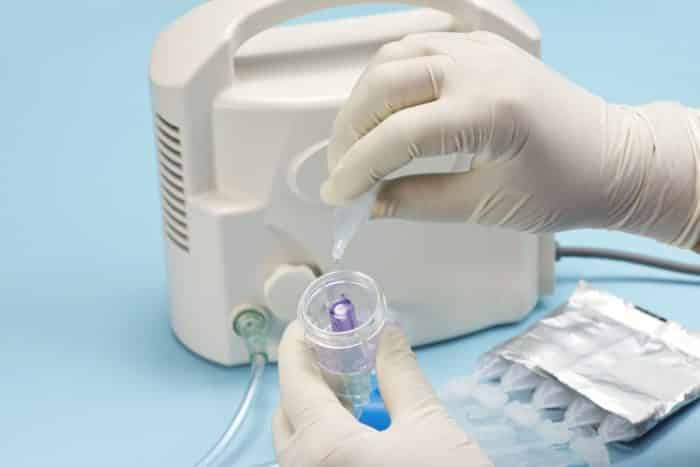
How to heat the solution?
The temperature of the liquid for inhalation should be in a certain range: from 36 degrees to 48. It is best when the solution has a temperature slightly higher than the human body. It is recommended to use only fresh saline solutions, but if this is not possible, then it can be heated by placing the container with it in a pan of warm water. Water should not get into the saline solution itself, and its temperature will cause the liquid to boil.
Dosage for inhalation
Inhalations must be carried out on an ongoing basis, otherwise the treatment will be useless. Against the runny nose, inhalations are carried out every 3-4 hours until the signs of the disease disappear. The percentage of salt in the solution should be 0.9%. This means that if you are preparing a solution with 100 grams of water, you need to place 0.9 grams of sodium chloride. If boiled water is 500 grams, then salt should be 4.5 grams. To determine exactly how much salt is needed, divide the mass of water by 100 and multiply by 0.9.
In theory, 9 grams of table salt is the mass of salt in one teaspoon. But the quality of salt from different manufacturers differs; it is impossible to determine such an exact gram by eye. If it is possible to measure the mass on a kitchen scale, then you need to use it. For inhalations for children, pour 3 milliliters of solution into the nebulizer, and do not stop the process until the liquid is completely gone. For adults, the dosage is 5-6 milliliters.
